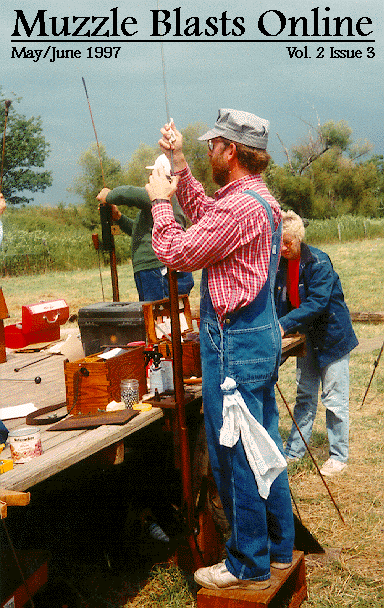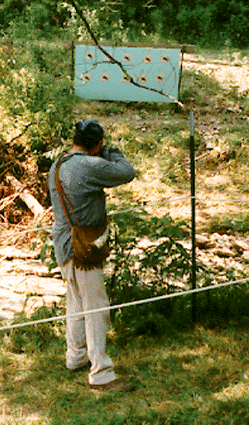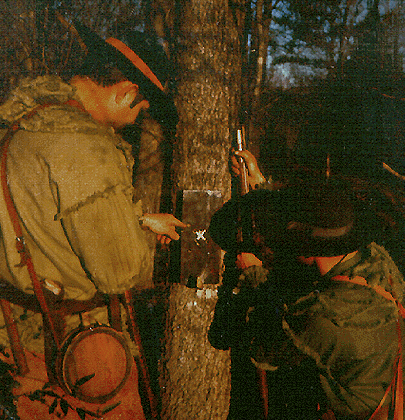|
Muzzle Blasts Online |
|
...for the muzzleloading enthusiast |
|
The muzzleblasts.com domain, subdomains, content, etc., are neither affiliated with the NMLRA nor its paper magazine Muzzle Blasts |
|
Muzzle Blasts Online |

|
|
|
|
|
|
What's a "Trailwalk"? (And What's not...)
Many years ago, I was invited to go "trout" fishing with a friend who lived in one of our southern states. I had been warned that "folks do things a bit differently down here" so I was staying bright-eyed and bushy-tailed. We got into a john boat and went streaking off at a good pace to his favorite fishing spot. My friend set me up with a spinning outfit much like I used in the pacific northwest. Nothing unusual here. The spinner was of a type I own. I was instructed to try casting near a downed tree. I did so, and in a short time I had a strike. The fish, while not enormous, put up quite a scrap. When it was in the net, my friend said, "That's a nice trout you got there." Right then I was thankful that I had been warned, so I did not blurt out anything about my "trout" really being a bass. I just said "Thanks" and put my "trout" into the live-box. To myself I said, "Yup, they do things a bit differently down here."

|
The group went walking off through the timber and soon came to the first target. The shooter loaded and mounted his rifle, ready to shoot. The camera panned to the target and ....Waugh! They had set up a 4' X 8' sheet of plywood and had stapled regular paper targets to it. Yes indeed, they do things differently there!
So what is wrong with having paper targets on a trail walk? Everything! Paper means you have to have scorers...people who have no time to shoot, they just work. There is constant down-time while targets are retrieved and posted. A primitive-shoot/woods-walk/trail-walk should have targets which tell you immediately if you have hit them or not. Trailwalk targets may have different point values, depending upon their difficulty, but the scoring should be simple and immediate. The target either clangs, swings, explodes, collapses, disappears, or waves a flag. Nobody has to futz about scoring reams of targets. Your scorekeeper is shooting right along with you, in most cases, and not going cross-eyed in the scoring shack. In a trailwalk, the emphasis is fun for all.
The roots of the trailwalk (woods walk) lie deep in America's past. There are reports of shooting at blocks and stake-cuts which date from the War of 1812. "Shooting to the mark" even pre-dates firearms. When the NMLRA was formed in 1933 by a group of black powder devotees (bless their souls), bib overalls and suntans were the uniform of the day and "farmer shoots" were the tradition. Some shot to the mark but modern paper targets were making a rapid inroad. While many small, local, black powder clubs organized across the country, few really prospered--formal target shooting may not appeal to everyone.
The idea of emulating the lifestyle and dress of the frontiersman has been with America for untold years and no one knows who set up the first muzzleloader trailwalk--possibly a reformed archer, because they had been doing such events for many years--but, in the late fifties, the two came together and coalesced into the buckskinning movement. The first modern rendezvous is said to have been held in August of 1958 at the Daniel Boone Club of Portsmouth, Ohio. They shot X-center on charred boards, at eggs, tacks, and paper diamond-centers. It didn't take long for the variety of targets to increase and for the firing points to move into the woods. The woods walk/trail walk was born. Suddenly, people who wanted to shoot with their friends, but found formal target shooting to be boring, had a sport of their own. The hunter who wanted a sport which approximated the problems faced on the hunt was attracted. The shooter who was turned off by the politics and over-emphasis on competition of many gun clubs found a home. The history nut who just wanted to "talk Hawken" found kindred spirits. Paper targets soon moved into the background, in many clubs, and the trailwalk took over as the major event. Rendezvousing went west as John Baird and the sadly short-lived National Association of Primitive Riflemen made changes in muzzleloading which energized the sport like nothing since the NMLRA first began. Muzzleloading clubs sprang up all over America and a rendezvous was held at Friendship, Indiana, in June of 1967, and the first NMLRA rendezvous west of the Mississippi took place at Chadron, Nebraska in 1973. Today, primitive shooting is a major part of the NMLRA program.
As the shooting program integrated itself with the camping, it became more and more a family sport and, in the process, buckskinning and the rendezvous have changed. The rifle events have also changed. The "farmer shoots" with everyone shooting from a fixed point at crude or paper targets are largely gone. The early western attitude of "if you feel like it, get a bunch together and go shoot something" is, for the most part, passé. Most clubs today have developed a well thought-out, if not uniform, system. In other clubs, the trailwalk has, like Topsy, "jest growed up" without thought or guidance. "So what?" you say. I believe that poorly set-up trailwalks have chased as many people away from black powder shooting as has the old-style formal paper punching. Let's examine what a well thought-out trailwalk should and should not be.
First of all, it out to be an exercise in marksmanship. It should give you practice shooting at different, and unknown, ranges at targets of different sizes and shapes. It is a good idea to require shooting from different positions, too. In short, it should emulate as much as possible the shots that one would take under actual hunting conditions. Shooting through a ring to hit a clanger imitates shooting through a hole in the brush to place your ball properly on game. A ball-split, tack-drive or card-cut requires the steadiness and fine hold needed in "barking" a squirrel.

|
This has not a ding-busted thing to do with rifle skills though, and should not be in a trailwalk anymore than a fire start, shooting a bow and arrow or sling shot, and "flanging" a spear or rock. If those fascinate you, set up a "primitive skills match" or some such thing, but don't mess up an exercise in marksmanship with that kind of extraneous flummery.
Now that I have some of you ticked at me, I might as well do it up right. Hawk and knife throwing have no place in a trailwalk. The historical precedent for these skills is, at best, tenuous. I have yet to find any contemporary account of their being thrown in actual combat. (Possibly because the mountain man who was dull-witted enough to throw away his weapon did not live long enough to write an account of the incident.) Sure, around winter camp some of them whiled away the time in throwing games, but to include such on a rifle trail makes about as much sense as having a game of mumbledy-peg as part of a yacht race, simply because sailors once played that game in their spare time.
Shooting skills, not the age or condition of your eyeballs, should be the major deciding factor on the trail. I have been to events where you had to have the eyes of a falcon even to find the clangers--let alone see them over your sights. This makes about as much sense as hanging all your targets behind bushes so that only people 6'2" and taller can see them. Few would pick on short people--so why pick on folks who happen to have eyesight which is a bit less than optimal? And while we are mentioning vision, let's remember to paint those clangers during the shoot. I know one club whose members are notorious for shooting Friday afternoon, knocking all the paint off of the targets, and leaving the targets unpainted and semi-visible for the rest of the weekend. They are not highly respected.
As long as I am throwing radical ideas at you, here is another one. Most of the trailwalk should not be terribly difficult. Not unless you are trying to keep our sport from growing. Each rendezvous will have a number of pilgrims, juniors, and/or ladies who are not yet very skilled. If they shoot the trail and come back with a score of zero, one, or two, they probably will not be back for another trailwalk. If they shoot the trail and score 15 out of 20, they will have had fun instead of frustration, and will probably be back. Those other five points, be they string-cut, ball-split, or whatever, are quite sufficient, when combined with a tie-breaker card, to divide the top shooters without embarrassing the "mangeurs de porc". If your club happens to be saddled with a guy who thinks that it is cute to run your rifle trail through creeks, wants to include the "flanging" of various hardware, or likes to camouflage the clangers, why not give him a bucket and a spade and let him play in the sandbox while the rest of you go set up the trailwalk?
Let us at this point take a walk on a well-constructed and thought out trail. I will try to explain the rationale behind each type of target and its placement. On most trails, the first thing you do is shoot your tie-breaker. Wrong! That's inappropriate for reasons of time and place. This is often the most important shot of the trail. To shoot it before you have fouled your barrel properly, settled your nerves, etc., makes little sense. The first shot should be a big "gimme". The greenest lard muncher in the bunch should be able to hit it. Don't sink his spirits and embarrass him on the first shot. (There is plenty of time for your sadistic tendencies to creep forward later.) The next three or four shots should get increasingly difficult, such as progressively small clangers. Keep the range fairly short, if possible, up to this point. We want to build confidence. Next comes the time to get tough. A tack-drive or jelly bean-bust makes shooters concentrate on sight picture and trigger control. Then throw in your tie-breaker shot. Most folks will be very close in the scoring, but this will start to open things up.
At this point, it is time to start stretching the range a bit and/or making the targets harder to hit. A metal disc about 8" in diameter at 50 yards is a snap. But one with a 4" hole in the center leaves only 2" around the edge. This is much harder for most folks to hit than a piece of 2" bar hanging out there. As the shot goes off, there is an unconscious tendency to drift to the center. Whatever you do, though, make sure that the impact can be properly detected. I well remember a big old logging hook which I shot at and "missed" at about 50 yards. I couldn't believe it until I stood off to one side and watched a shooter with a .50 caliber splatter his ball all over the thing. The scorer couldn't see any swing, so it was scored as a miss. My .40 caliber didn't have a chance. If the target won't ring, make sure it will swing.
Too much of a good thing can be bad, also. Hang your targets with some sort of a damper on them. A trail will slow to a crawl if a target continues to swing for several minutes after being hit. This isn't bad on a big clanger which swings fore-and-aft, but on a chain or other small target which can oscillate in several directions, it is a real pain. (Editor's note: I have seen gongs damped with bungee cords and with loose chains attached to anchor points left and right to limit swing and keep the targets facing forward. Both methods work well if dampers are fastened securely and quick to repair when necessary). Also make sure that your clangers, etc., are well made and hung. At one big rendezvous which I attended, they spent as much time repairing as they did shooting. More than one participant made interesting speculations as to the ancestry of the skinners who had set up that trail!
O.K. Now that we have stretched the range out and toughened up on the targets, bring the range back down for a ball-split or card-cut, then zoom it back out for a long shot. Make them think about sight picture, load, and trajectory. By now, your scores will have opened out a bit, but no one should have a score so low as to be discouraging or embarrassing. Of course, there will be, from time to time, an occasional participant who simply cannot shoot, or will not spend the time to learn. Trying to make a trail that will give him success is as futile as trying to make the world safe for the kind of individual who can kill himself peeling a banana. We need not go to ridiculous extremes but let's end the trail with a fairly easy shot so that everyone but the total klutz (like me on one of my many "off days") gets the last one. "Leave 'em laughing" as the vaudevillians say.
Now, let's tally the scores. I guarantee that you will have little difficulty figuring out who goes to the blanket first, second, and so forth. You also will not have a bunch of folks ditching their score cards in embarrassment and vowing never again to subject themselves to such humiliation. Rendezvousing should be fun for the whole family. All of rendezvousing--not just the camping. And all of the family, not just the adults.
I recently got a letter from a friend back East who wanted his 10 year old son to try shooting a rifle trail. The youngster was eager, and dad was hopeful, but the club putting on the shoot was competition-oriented to the point of silliness. He had to shoot his dad's rifle off-hand, and thus ended up in tears at his lack of success. This is comparable to forcing adult shooters to use guns weighing at least 20 pounds. Shooters 12 years of age and under should be in the "sub-junior" category and allowed to shoot off cross-sticks. Especially for the youngsters, success is vital. The disheartened beginner never becomes a seasoned shooter. But the youth who just finished within five points of the local champion will one day be back to become the local champ himself. Isn't that a major portion of what our sport is all about?
(Editor's note: In setting up a woods walk, choose and set your targets with the utmost attention to safety. Minimize concerns about backsplatter and ricochets by keeping steel gongs a safe distance away and in a secure impact area. Once the targets are set up, shoot the course to be sure that targets are visible and behave as expected, and that no safety concerns have been overlooked.)